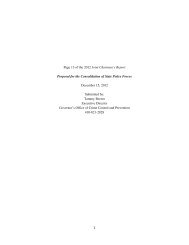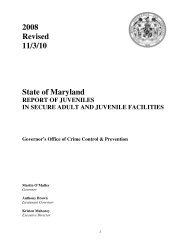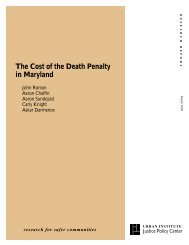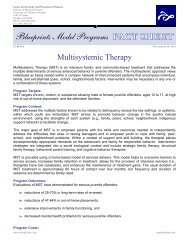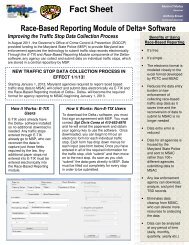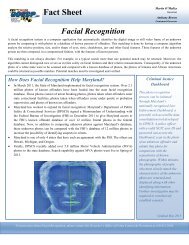Targeted Outreach - Governor's Office of Crime Control & Prevention ...
Targeted Outreach - Governor's Office of Crime Control & Prevention ...
Targeted Outreach - Governor's Office of Crime Control & Prevention ...
You also want an ePaper? Increase the reach of your titles
YUMPU automatically turns print PDFs into web optimized ePapers that Google loves.
36 <strong>Targeted</strong> <strong>Outreach</strong><br />
Table 12<br />
Source <strong>of</strong> GPTTO and GITTO Youth<br />
<strong>Prevention</strong> Clubs (n=21)<br />
Source <strong>of</strong> Target Youth What was the lowest What was the highest What were the average<br />
percent <strong>of</strong> percent <strong>of</strong> and median<br />
target youth target youth percent <strong>of</strong><br />
referred to a Club? referred to a Club? target youth<br />
referred to a Club?<br />
Direct <strong>Outreach</strong> 0 83 35/39<br />
Juvenile Justice (police, probation, courts) 0 16 3/0<br />
School 0 89 18/8<br />
Parents 0 82 27/27<br />
Intervention Clubs (n=3)<br />
Source <strong>of</strong> Target Youth What was the lowest What was the highest What were the average<br />
percent <strong>of</strong> percent <strong>of</strong> and median<br />
target youth target youth percent <strong>of</strong><br />
referred to a Club? referred to a Club? target youth<br />
referred to a Club?<br />
Direct <strong>Outreach</strong> 0 60 29/28<br />
Justice (police, probation, courts) 2 58 24/11<br />
School 7 35 22/23<br />
Parents 6 26 15/12<br />
resolution component into the basketball activity<br />
instead <strong>of</strong> asking the youth to attend a separate conflict<br />
resolution program.<br />
In essence, to fully engage these youth, staff needed<br />
to make sure that youth got involved in programming<br />
that met their interests. Additionally, however,<br />
the philosophy assumes that if Clubs cannot identify<br />
youth’s needs and address them, gangs will fill those<br />
gaps. If Club activities are not interesting and engaging,<br />
the youth will not stay involved.<br />
To ensure that staff met the needs <strong>of</strong> the youth and<br />
addressed them through appealing, engaging activities,<br />
staff had to complete a program plan for each<br />
target youth brought into the Club. The program<br />
plan helps the staff think about the youth’s interests<br />
and needs, identify existing programs that are appropriate<br />
for the youth or discover if there is a need to<br />
create new programming. From the documentation<br />
we received, we found that slightly more than half<br />
the Clubs (54%) created a program plan and made<br />
suggestions for youth to participate in combined<br />
interest/needs-based programming over the course<br />
<strong>of</strong> the evaluation year. Furthermore, subsequent documentation<br />
that tracked youth’s participation in<br />
combined interest/needs-based programming indicated<br />
that just over one-quarter (28%) <strong>of</strong> tracked<br />
youth continued to participate in interests/needsbased<br />
programming four months after intake.<br />
Our site visit interviews with staff, along with phone<br />
conversations during the course <strong>of</strong> the evaluation,<br />
confirmed that developing interest-based programs<br />
that address the needs <strong>of</strong> youth at the same time is<br />
very difficult for several reasons. A number <strong>of</strong> Clubs<br />
had hired program staff after the training sessions had<br />
taken place and therefore these staff were not trained<br />
in the needs/interests-based programming component<br />
<strong>of</strong> the model. Other Clubs used a rotating



